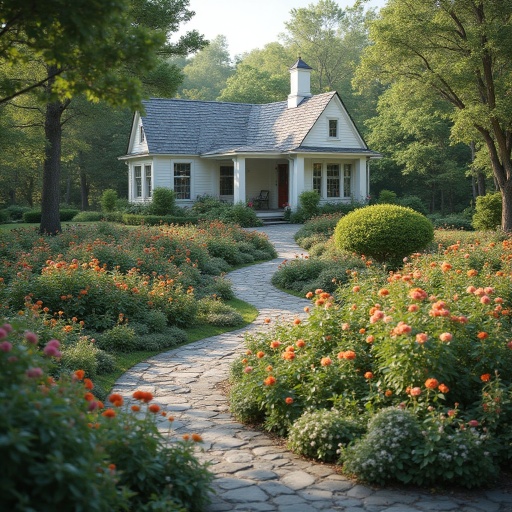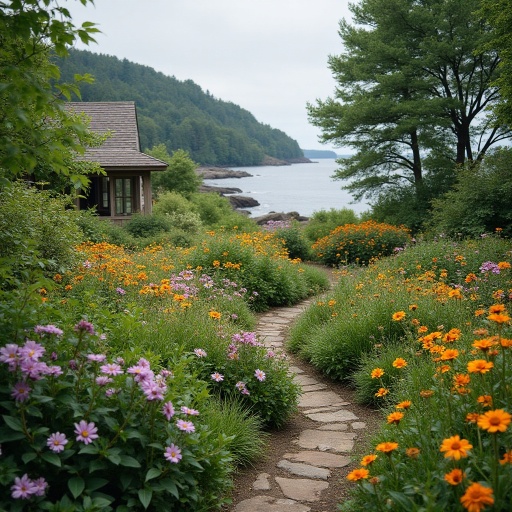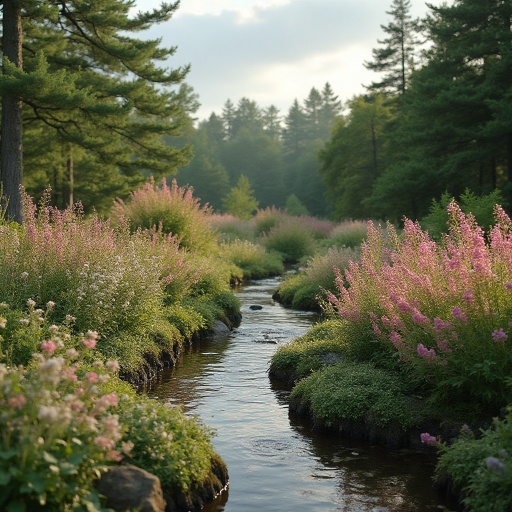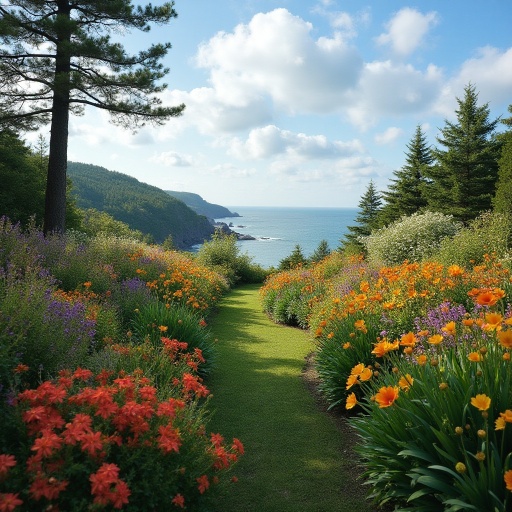Coastal Maine Botanical Gardens: Garden Design Ideas That Will Transform Your Space

Did you know that garden design can increase your property value by up to 20% while significantly improving your mental wellbeing? The breathtaking Coastal Maine Botanical Gardens offers an inspirational showcase of garden design ideas that blend artistry with nature’s beauty. Nestled along Maine’s rugged coastline, this horticultural paradise demonstrates how thoughtful garden design transforms ordinary spaces into extraordinary landscapes that captivate the senses and nurture the soul.
Information About Coastal Maine Botanical Gardens
Coastal Maine Botanical Gardens stands as New England’s largest botanical garden, spanning 295 acres of breathtaking coastal landscape. The gardens feature:
- Native and cultivated plantings that showcase Maine’s unique botanical heritage
- Diverse garden spaces including formal gardens, woodland trails, and coastal shoreline
- Award-winning designs that incorporate sustainable landscaping practices
- Seasonal displays that demonstrate garden design ideas for year-round interest
- Accessibility features that make garden enjoyment possible for visitors of all abilities
The gardens serve as a living laboratory for landscape design innovations, offering endless inspiration for home gardeners looking to enhance their own outdoor spaces.
Timing
A typical visit to Coastal Maine Botanical Gardens ranges from 3-5 hours, allowing enough time to explore the primary garden areas and enjoy their seasonal beauty. For garden design enthusiasts seeking deeper inspiration, consider planning a full-day visit or returning across different seasons to witness how the landscape transforms. The average visitor spends approximately 3.5 hours exploring the gardens, though photography enthusiasts and serious gardeners often extend their visits to capture design details and plant combinations.
Step-by-Step Tour for Garden Design Inspiration
Step 1: Begin at the Visitor Center
Start your garden design journey at the LEED-certified Visitor Center, which demonstrates how architecture can harmonize with landscape. Notice how the building’s positioning creates a natural flow into the gardens while providing framed views of key garden features. The surrounding plantings showcase how entrance gardens can create a welcoming transition between built structures and natural spaces.
Step 2: Explore the Lerner Garden of the Five Senses
This thoughtfully designed garden demonstrates how engaging all five senses creates a more immersive landscape experience. Observe how:
- Textural plantings invite touch
- Fragrant herbs and flowers enhance the sensory experience
- Flowing water features add soothing sounds
- Edible plantings engage taste
- Carefully composed color schemes delight the eye
Take note of how these sensory elements could be incorporated into your own garden design on a smaller scale.
Step 3: Wander Through the Children’s Garden
Even if you don’t have children, this garden offers innovative design ideas for creating playful, interactive spaces. Notice how:
- Themed garden rooms create distinct experiences within a cohesive design
- Vertical elements add height and visual interest
- Whimsical features can be incorporated into sophisticated designs
- Learning opportunities are seamlessly integrated into the landscape
Consider how these elements might inspire your own garden to become more engaging and interactive.
Step 4: Discover the Meditation Gardens
These tranquil spaces demonstrate how garden design can create contemplative environments. Pay attention to:
- How plant selections create a sense of calm
- The use of negative space in the design
- The thoughtful placement of seating areas
- The way paths guide movement through the space
These design principles can help you create restful spaces in your own landscape.
Step 5: Experience the Native Gardens
Observe how indigenous plants are showcased in designs that honor Maine’s natural heritage while creating beautiful, sustainable landscapes. Note:
- How native plants are arranged to create visual interest
- The use of naturalistic planting patterns
- How maintenance practices support ecological health
- The integration of habitat features within the aesthetic design
These approaches can be adapted for creating more sustainable, place-appropriate garden designs at home.

Technical and Artistic Information
Coastal Maine Botanical Gardens was founded in 1996 by a group of Maine residents who shared a vision of creating a world-class public garden. After years of planning and development, the gardens officially opened to the public in 2007. Located in Boothbay, Maine, the property encompasses 295 acres with nearly a mile of tidal shorefront.
The climate features cold, snowy winters and moderate summers, creating a USDA hardiness zone 5b environment that presents both challenges and opportunities for garden design. Water resources include natural watershed areas, streams, and ponds, which have been thoughtfully incorporated into the landscape design.
The garden’s mission focuses on inspiring meaningful connections among people, plants, and nature through horticulture, education, and research.
Notable garden areas include:
- The Alfond Children’s Garden: A 2-acre interactive space inspired by Maine children’s literature
- Lerner Garden of the Five Senses: A therapeutic landscape designed to engage all senses
- Burpee Kitchen Garden: Showcasing edible landscaping designs and organic growing techniques
- Rhododendron Garden: Featuring woodland design principles with paths winding through spectacular collections
- Rose & Perennial Garden: Demonstrating classic flower garden design with contemporary sustainability practices
- Arbor Garden: Highlighting vertical gardening techniques and structural elements
- Meditation Gardens: Illustrating principles of contemplative landscape design
- Haney Hillside Garden: Showcasing solutions for sloped terrain with cascading water features
- Vayo Meditation Garden: A serene space demonstrating minimalist design principles
- Bibby and Harold Alfond Woodland Garden: Featuring native plant communities in naturalistic designs
What distinguishes Coastal Maine Botanical Gardens from other public gardens is its integration of horticultural excellence with ecological sensitivity and its emphasis on connecting visitors with Maine’s unique natural heritage. The garden’s plant patterns often echo the rhythms of the surrounding coastal landscape, with special attention to seasonal interest.
Visitor infrastructure includes:
- Paved accessible pathways connecting major garden areas
- Educational signage with QR codes linking to detailed plant information
- Strategically placed seating areas
- Shuttle service for those with mobility concerns
- Ecologically designed stormwater management systems
Amenities for visitors include:
- Kitchen Garden Café offering seasonal, locally-sourced food
- Garden Shop featuring unique plants and garden accessories
- Education Center with regularly scheduled workshops on garden design
- Research facilities supporting plant conservation efforts
- Event spaces for weddings and corporate gatherings
- Five miles of hiking trails through natural areas
- Outdoor classrooms for educational programming
Annual events include:
- Gardens Aglow (November-December): A spectacular winter light display
- Native Plant Festival (May): Celebrating indigenous flora and sustainable design
- Maine Botanical Art Exhibition (July-August): Featuring botanical illustrations
- Fairy House Festival (August): Showcasing miniature garden design
- Fall Foliage Festival (October): Celebrating seasonal color in the landscape
The gardens are open daily from April through October and Thursday through Sunday in November and December for Gardens Aglow. Adult admission is $22, with discounts for seniors, children, and members. Annual membership provides unlimited access and additional benefits.
The gardens are managed by a professional staff of horticulturists, educators, and administrators, overseen by a Board of Directors. The maintenance team includes specialists in ecological management practices who preserve the gardens’ beauty while minimizing environmental impact.
Visitors come from throughout New England, across the United States, and internationally, with approximately 250,000 annual guests. The gardens contribute significantly to the local economy while providing educational resources for the community and supporting plant conservation efforts.

Healthy Alternatives to Coastal Maine Botanical Gardens
If you’re seeking additional garden design inspiration in the region, consider:
- Thuya Garden in Northeast Harbor, Maine: A smaller garden featuring classic New England design elements
- Beatrix Farrand Garden at Garland Farm: Showcasing the work of America’s first female landscape architect
- Asticou Azalea Garden: Offering Japanese-inspired garden design principles
- Camden Maine Public Library Garden: Demonstrating how public spaces can incorporate exceptional landscape design
For families with diverse interests, consider combining your garden visit with:
- Nature photography outings along nearby hiking trails
- Educational workshops on sustainable gardening practices
- Picnicking in designated garden areas with your own healthy refreshments
- Sketching or painting sessions inspired by the garden’s beauty
Introductory Garden Design Suggestions
For those inspired to enhance their own landscapes after visiting Coastal Maine Botanical Gardens, consider these starting points:
- Begin with a small “garden room” that can be completed in a weekend
- Incorporate native plants that support local pollinators
- Create a simple water feature to add sensory appeal
- Design a focal point using a specimen plant or garden ornament
- Add a comfortable seating area that encourages garden enjoyment
Personalize your garden by:
- Including plants with personal meaning or family significance
- Creating themed areas that reflect your interests and passions
- Incorporating found objects from nature or travel as garden art
- Designing spaces that support activities you enjoy, like reading or entertaining
Common Mistakes to Avoid
When implementing garden design ideas, avoid these common pitfalls:
- Overcrowding plants without considering their mature size (50% of home gardeners make this mistake)
- Neglecting soil preparation, which accounts for 80% of plant failure in new gardens
- Creating high-maintenance designs that become overwhelming
- Ignoring seasonal interest, resulting in gardens that lack appeal for portions of the year
- Overlooking the importance of pathways and circulation patterns
Instead, follow a thoughtful design process, starting with site analysis and developing a plan that respects both natural conditions and personal lifestyle needs.
Visitor Encouragement Tips
Enhance your Coastal Maine Botanical Gardens experience with these activities:
- Join a guided tour to gain deeper insights into design principles
- Participate in a seasonal workshop on garden techniques
- Document inspiring plant combinations with photographs for future reference
- Sketch garden layouts that particularly appeal to you
- Collect plant lists from garden areas that match your home conditions
To maintain a positive environmental impact:
- Bring reusable water bottles and refill at water stations
- Stay on designated paths to protect plantings
- Respect wildlife encountered throughout the gardens
- Consider carpooling or using shuttle services when available
Conclusion
Coastal Maine Botanical Gardens offers an unparalleled source of garden design ideas that blend artistic vision with ecological wisdom. From sensory-rich landscapes to sustainable native plantings, these gardens demonstrate how thoughtful design transforms outdoor spaces into havens of beauty and meaning. Visit these remarkable gardens to discover inspiration that will elevate your own landscape to new heights.
We’d love to hear about your visit! Share your favorite garden design inspirations in the comments section below or subscribe to our newsletter for seasonal gardening tips and upcoming events.

Frequently Asked Questions
When is the best time to visit Coastal Maine Botanical Gardens for garden design inspiration?
Each season offers unique design lessons. Spring showcases bulb and early perennial combinations, summer displays the gardens at peak bloom, fall demonstrates spectacular color planning, and the winter light show illustrates creative hardscape use. For maximum inspiration, consider multiple visits throughout the growing season.
Can I bring plants home from Coastal Maine Botanical Gardens?
While you can’t collect plants from the gardens themselves, the Garden Shop offers many plants featured in the garden designs, including native species and unusual cultivars. Staff can provide advice on selecting plants suitable for your growing conditions.
How can I adapt the garden designs I see to my smaller home landscape?
Focus on capturing the essence of designs that inspire you rather than trying to replicate them exactly. Notice plant combinations, color schemes, and textures that could work at a smaller scale. The gardens’ staff can often suggest space-appropriate alternatives to larger specimens.
Are there resources available for continuing garden design education after my visit?
Yes! The gardens offer online classes, in-person workshops, and a resource library. Their website features planting guides, design articles, and a plant database. Additionally, becoming a member provides access to special educational programming throughout the year.
How accessible are the gardens for visitors with mobility challenges?
Most major garden areas are accessible via paved pathways suitable for wheelchairs and mobility scooters. The gardens offer shuttle services between garden areas and accessible restrooms throughout the property. Some woodland trails may present challenges, but the primary designed gardens can be enjoyed by visitors of all mobility levels.
